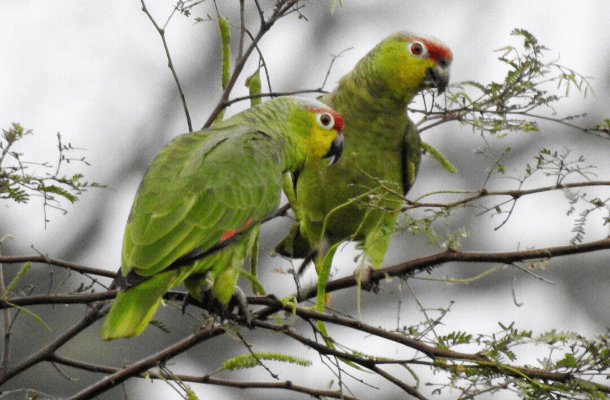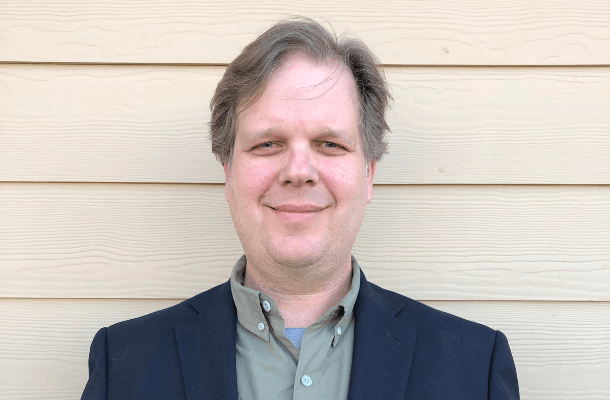Completing Las Balsas Communal Reserve for the Lilacine Amazon

The Lilacine Amazon and other birds received additional protection and habitat with completion of the Las Balsas Communal Reserve in Ecuador. Photo by Michael Moens, Fundación Jocotoco
Fundación de Conservación Jocotoco, with support from American Bird Conservancy (ABC) and Rainforest Trust, has purchased a total of 46 long-term lease agreements with Ecuador's Las Balsas community to protect the largest known population of the Lilacine Amazon. This colorful parrot is found only in western Ecuador and is listed as Endangered on the IUCN Red List of Threatened Species. The reserve started in November 2019 with the protection of 32 acres.
Now covering 246 acres, the reserve is about a third the size of New York City's Central Park. It is comprised mostly of carob tree woodlands used by the birds for roosting and complements the areas protected by the community. These roost sites have been in use by Lilacine Amazons for as long as community members can recall — over 50 years. The numbers of birds recorded during regular roost counts conducted by Fundación Jocotoco are truly extraordinary: In fact, the maximum count of 2,570 individual Lilacine Amazons exceeds the previously estimated total world population for the species.
“We knew the numbers were significant,” says Dr. Martin Schaefer, CEO of Fundación Jocotoco. “But we were blown away when our censuses showed us just how significant. We are grateful to the Las Balsas community for the opportunity to protect these key areas and manage them for the long-term protection of the Lilacines.”
“And the benefits extend beyond Lilacine Amazons,” noted Dr. Michael Moens, Jocotoco's Conservation Director. “Our partnership with the community means that we have the ability to collaborate with them on the conservation of the Great Green Macaw over the broader 25,000 acres of land under community management.” Las Balsas is home to the only known population of the Critically Endangered guayaquilensis subspecies. Fifteen wild macaws have been supplemented with six captive-bred individuals released by Fundación Jocotoco, and Jocotoco has confirmed nesting by four pairs in Las Balsas.
The next steps for the fledgling Las Balsas Reserve and the Las Balsas community focus on land management, monitoring, and research needed to thwart threats to the Lilacine Amazon and the Great Green Macaw and to inform ongoing conservation action. Fundación Jocotoco is installing signs to mark the new reserve's boundaries, and putting up fencing to restrict access and to keep livestock out of the most vulnerable areas. The organization is also exploring sustainable ways the community can create more products from the area's carob trees.
Some of the most exciting developments will use technology to learn more about the amazon and the macaw and to enhance reserve protections. Fundación Jocotoco plans to use radio telemetry to study Lilacine Amazon movements in the greater Las Balsas area. While the roosting areas are well known, where the Lilacines nest is not. Telemetry data will shed light on key nesting areas and broaden understanding of the species' habitat usage and needs.
Fundación Jocotoco is partnering with Rainforest Connection (https://www.rfcx.org/) to enhance both population monitoring and the protection of those areas that the Las Balsas community set aside for protection. Rainforest Connection has pioneered the use of second-hand cellphones, which are refurbished and paired with arrays of small solar panels. When mounted high in trees, these phones, called Rainforest Guardians, become listening stations that detect the sounds of chainsaws or gun shots, sending warnings to forest guards in real time.
Jocotoco and Rainforest Connection will also deploy 70 Rainforest Connection Edge devices, which are small, passive-recording units that can continuously monitor forest sounds, including vocalizations of Lilacines and macaws and other high-priority species, such as the Critically Endangered Ecuadorian Capuchin monkey. Sound recordings can be downloaded at regular intervals and then screened for the vocalizations of target species. Changes in the type, distribution, and frequency of the sounds of Lilacine Amazons, for example, will provide information about the numbers of amazons and where and when they occur throughout the year and over time.
“We extend our congratulations to Fundación Jocotoco,” says Dr. George Wallace, ABC's Director of International Programs and Partnerships. “We are very proud to be a part of this effort, which blends classic land protection approaches with cutting-edge technology to make our collective conservation efforts even more effective.”
Work to conserve this area and its threatened parrots is supported by American Bird Conservancy, Fundación Jocotoco, Rainforest Trust, Tropical Forest Forever Fund at Gulf Coast Bird Observatory, David and Patricia Davidson, Ted Reissing, and an anonymous donor.
###
Media Contact: Jordan Rutter, Director of Public Relations, 202-888-7472 | jerutter@abcbirds.org | @JERutter
Expert Contact: George Wallace, Director of International Programs and Partnerships gwallace@abcbirds.org
American Bird Conservancy is a nonprofit organization dedicated to conserving birds and their habitats throughout the Americas. With an emphasis on achieving results and working in partnership, we take on the greatest problems facing birds today, innovating and building on rapid advancements in science to halt extinctions, protect habitats, eliminate threats, and build capacity for bird conservation. Find us on abcbirds.org, Facebook, Instagram, and Twitter (@ABCbirds).


















































